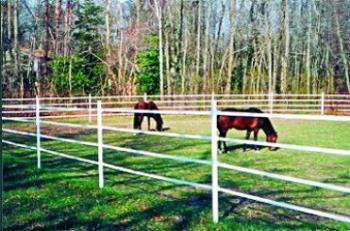How Many Rails?

Many horse owners position the top rail at wither height, which will give you a taller fence if you have taller horses. On average, top rail height runs 52-54 inches.
Ideally, you want to maintain a space of 9-11 inches between rails.
Position the top edge of the top rail two inches from the top of the post. Position the bottom edge of the bottom rail approximately one foot from the ground. Determine how many rails you will need to place in between to maintain appropriate spacing. Make sure there is not enough space for your horse to get both his head and leg through the rails; this can invite him to ''walk through'' the fence.
If you have smaller horses or animals, you will need to tighten up the space between rails.
With a nursery paddock where you'll be keeping foals, consider a five-rail configuration. The lower three rails can be spaced closer together while the top two are placed further apart. This provides a more secure fence for the young horse with wider spacing as he grows.
Other considerations include:
- Adding a rail (or more) of electric. This will minimize contact between your horses and the fence, resulting in less wear-and-tear.
- Keep in mind the number of horses you keep now or will keep in the future.
- Be aware of your horses' varying temperaments.
- Basic rail guidelines, based on top rail being at 52 to 54 inches:
- 5.25 inch rail = 4 rails
- 4.25 inch rail = 4 rails
- 1 inch rail = minimum of 4 rails with an electric rail suggested
- Coated Wire = minimum of 5 strands with an electric rail suggested
- 1.5 inch Electric Tape= 4 rails

